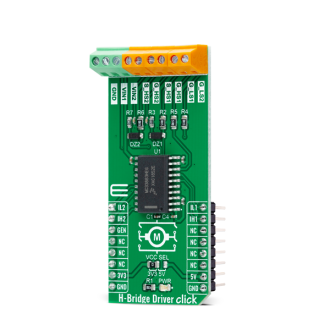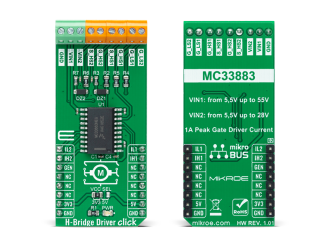
We strongly encourage users to use Package manager for sharing their code on Libstock website, because it boosts your efficiency and leaves the end user with no room for error. [more info]

Rating:
Author: MIKROE
Last Updated: 2021-07-12
Package Version: 1.0.0.0
mikroSDK Library: 1.0.0.0
Category: Motor control
Downloaded: 2659 times
Not followed.
License: MIT license
H-Bridge Driver Click is a compact add-on board that contains an H-bridge gate driver, also known as a full-bridge pre-driver. This board features the MC33883, an H-Bridge gate driver with an integrated charge pump and independent high and low side gate drive channels from NXP Semiconductors.
Do you want to subscribe in order to receive notifications regarding "H-Bridge Driver click" changes.
Do you want to unsubscribe in order to stop receiving notifications regarding "H-Bridge Driver click" changes.
Do you want to report abuse regarding "H-Bridge Driver click".


Library Description
The library covers all the necessary functions to control the H-Bridge Driver Click board™. User can use functions that control four separate input pins.
Key functions:
void hbridgedriver_glo_enable ( uint8_t state ); - Function is used to turn the device on or off.void hbridgedriver_in_ls_2 ( uint8_t state ); - Function is used to set the state of the 'IL2' pin.void hbridgedriver_in_ls_1 ( uint8_t state ); - Function is used to set the state of the 'IL1' pin.Examples description
The application is composed of three sections :
void application_task ( )
{
mikrobus_logWrite( "The motor turns forward!", _LOG_LINE );
hbridgedriver_forward( );
Delay_ms( 1000 );
mikrobus_logWrite( "The motor brakes!", _LOG_LINE );
hbridgedriver_braking( );
Delay_ms( 1000 );
mikrobus_logWrite( "The motor turns in reverse", _LOG_LINE );
hbridgedriver_reverse( );
Delay_ms( 1000 );
mikrobus_logWrite( "The motor coasting", _LOG_LINE );
hbridgedriver_coasting( );
Delay_ms( 1000 );
}
Other mikroE Libraries used in the example:
Additional notes and informations
Depending on the development board you are using, you may need USB UART click, USB UART 2 click or RS232 click to connect to your PC, for development systems with no UART to USB interface available on the board. The terminal available in all MikroElektronika compilers, or any other terminal application of your choice, can be used to read the message.